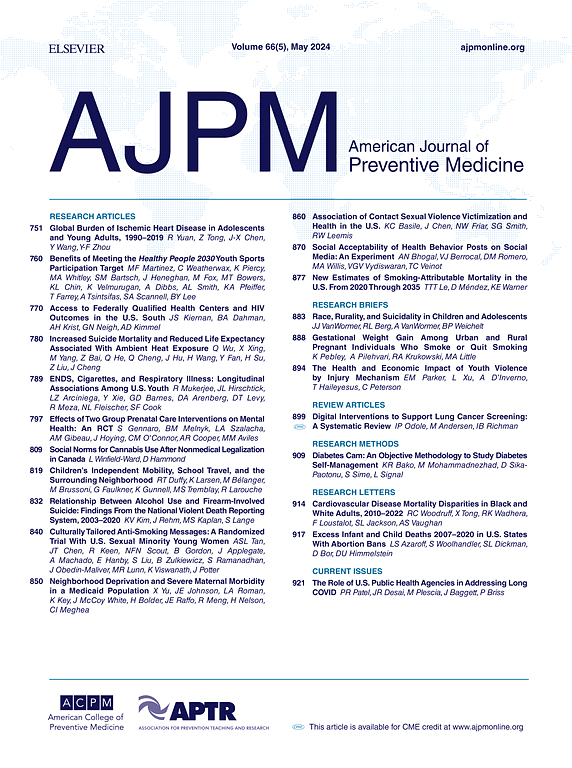Disease Intervention Specialist-Delivered Interventions and Other Partner Services for HIV and Sexually Transmitted Infections: A Systematic Review
IF 4.3
2区 医学
Q1 MEDICINE, GENERAL & INTERNAL
引用次数: 0
Abstract
Introduction
Disease intervention specialists (DIS) are critical for delivering partner services programs that provide partner notification, counseling, referral, and other services for HIV, sexually transmitted infections (STIs), and other infections. This systematic review of partner services and other DIS-delivered interventions for HIV and STIs was conducted to summarize the effectiveness of these programs and identify evidence gaps.
Methods
A systematic literature review was conducted with a narrative synthesis. Articles were located using keyword searches in MEDLINE, Web of Science, CINAHL, and ProQuest through December 2022 and analyzed in 2023–2024. Included studies addressed an intervention of partner services or other DIS-delivered services for HIV or STIs; a United States setting; primary data collection; and an external comparison group or pre-post design.
Results
A total of 1,915 unique records were screened for eligibility, with 30 studies included. Overall, DIS-delivered interventions improved clinical outcomes among index patients and population outcomes. Many studies focused on program process measures rather than population-level epidemiologic outcomes. All but one studies were scored as having low or medium strength of evidence.
Conclusions
The evidence could be strengthened by establishing a streamlined set of core metrics, assessing impact using rigorous causal inference methodologies, linking program and clinical data systems, and supplementing impact evaluations with evidence on implementation strategies.
疾病干预专家提供的艾滋病毒和性传播感染干预措施及其他伙伴服务:系统综述。
导言:疾病干预专家(DIS)对于提供伴侣服务项目至关重要,这些项目针对 HIV、性传播感染(STI)和其他感染提供伴侣通知、咨询、转诊和其他服务。本研究对伴侣服务和其他 DIS 提供的 HIV 和 STI 干预措施进行了系统性回顾,以总结这些计划的有效性并找出证据差距:方法:采用叙述性综合方法进行了系统性文献综述。截至 2022 年 12 月,通过在 MEDLINE、Web of Science、CINAHL 和 ProQuest 中进行关键词搜索找到了相关文章,并于 2023-2024 年进行了分析。所纳入的研究涉及伴侣服务干预或其他由 DIS 提供的 HIV 或 STI 服务;美国环境;主要数据收集;外部比较组或前后期设计:共筛选出 1,915 条符合条件的记录,其中包括 30 项研究。总体而言,DIS 提供的干预措施改善了指标患者的临床疗效和人群疗效。许多研究关注的是项目过程措施,而不是人群层面的流行病学结果。除一项研究外,其他研究均被评为低度或中度证据强度:讨论:通过建立一套精简的核心指标、使用严格的因果推论方法评估影响、将项目和临床数据系统联系起来,以及通过实施策略方面的证据对影响评估进行补充,可以加强证据的说服力。
本文章由计算机程序翻译,如有差异,请以英文原文为准。
求助全文
约1分钟内获得全文
求助全文
来源期刊

American Journal of Preventive Medicine
医学-公共卫生、环境卫生与职业卫生
CiteScore
8.60
自引率
1.80%
发文量
395
审稿时长
32 days
期刊介绍:
The American Journal of Preventive Medicine is the official journal of the American College of Preventive Medicine and the Association for Prevention Teaching and Research. It publishes articles in the areas of prevention research, teaching, practice and policy. Original research is published on interventions aimed at the prevention of chronic and acute disease and the promotion of individual and community health.
Of particular emphasis are papers that address the primary and secondary prevention of important clinical, behavioral and public health issues such as injury and violence, infectious disease, women''s health, smoking, sedentary behaviors and physical activity, nutrition, diabetes, obesity, and substance use disorders. Papers also address educational initiatives aimed at improving the ability of health professionals to provide effective clinical prevention and public health services. Papers on health services research pertinent to prevention and public health are also published. The journal also publishes official policy statements from the two co-sponsoring organizations, review articles, media reviews, and editorials. Finally, the journal periodically publishes supplements and special theme issues devoted to areas of current interest to the prevention community.
 求助内容:
求助内容: 应助结果提醒方式:
应助结果提醒方式:


